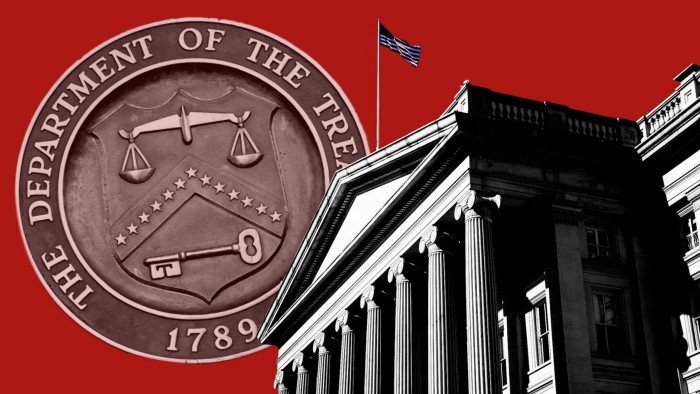Crypto corporations and merchants are pouring billions of {dollars} into tokenised variations of cash market and Treasury bond mutual funds, as they appear past stablecoins to different locations to park extra money that may additionally give them some yield.
Complete property held in tokenised Treasury merchandise — which embody funds whose items have been transformed into digital tokens in addition to some tokenised US government bonds — have jumped 80 per cent to date this yr to $7.4bn, in accordance with information group RWA.xyz. Funds run by BlackRock, Franklin Templeton and Janus Henderson have grown significantly quickly, with mixed property tripling.
Inflows have been pushed partly by crypto merchants, a lot of whom are discovering tokenised funds a extra enticing place than stablecoins to park their cash. Some buyers are additionally beginning to use these funds as an easy-to-trade type of collateral in crypto derivatives transactions.
“Stablecoins had been the place holder, tokenised cash market funds are the true deal. Merchants are beginning to make the swap,” stated Olivier Portenseigne at FundsDLT, which is a part of the clearing home Clearstream.
“Tokenisation . . . supplies a less expensive and simpler method to purchase mutual funds, and liquidity is enhanced,” he added.
The election of pro-crypto US President Donald Trump has triggered a contemporary wave of enthusiasm that blockchain-based know-how can modernise the plumbing of economic markets, the place the pace at which offers are settled nonetheless lags far behind the tempo at which buying and selling info is processed.
Tokenising cash market funds creates a digital model of one of the crucial conservative asset administration merchandise, which may then be held on a ledger. Proponents say tokenisation encourages sooner and cheaper buying and selling as a result of Treasuries and cash market funds could be accepted as collateral.
Settlement occasions on a blockchain are minutes somewhat than days — which reduces capital necessities — whereas dangers in assembly margin funds and administration bills for the asset supervisor are additionally decrease, they are saying.
McKinsey estimates the marketplace for tokenised mutual funds, bonds and trade traded notes may develop to $2tn. Conventional US cash market funds at current handle about $7tn in property.
To this point, the principle demand for tokenised bond and cash market funds has come from crypto merchants, who’re more and more utilizing them as an alternative choice to stablecoins.
The latter — often used as a spot to park money earlier than or after buying and selling different tokens — are pegged to and denominated in a tough forex and thus don’t change in value, but in addition don’t supply any yield to holders. Tokenised cash market funds present extra safety than stablecoins, say analysts, whereas offering the investor with yield.
Crypto buyers can use tokenised merchandise to carry any spare money “in a format that’s straightforward to make use of and, in contrast to most stablecoins, permits them to earn a yield”, wrote Stephen Tu, an analyst at Moody’s, in a current report.
One other supply of development has been stablecoin issuers themselves, which have invested the reserves that again their tokens into high-quality, yield-bearing property. Janus Henderson’s $409mn tokenised Treasury Fund (JTRSY) is primarily backed by one consumer, Sky Cash, the third-largest stablecoin issuer.
As well as, buyers are additionally beginning to use these tokenised US Treasury merchandise as collateral when buying and selling on margin, for example in over-the-counter by-product trades akin to rate of interest swaps. Doing so signifies that merchants are — like nonstop crypto markets — now not tied to the operational hours of banks for funds and commerce settlement.
In an indication of rising enthusiasm on Wall Avenue for tokenised collateral, final month a number of teams, together with US buying and selling firm DRW Buying and selling, bond market platform Tradeweb Markets, BNP Paribas, Citadel Securities and Goldman Sachs collectively invested $135mn in Digital Asset, whose Canton Community blockchain holds tokenised property akin to bonds and repurchase agreements. YZi, the household funding workplace of former Binance chief govt Changpeng Zhao, was additionally a part of the fundraising.
Digital Asset chief govt Yuval Rooz stated the corporate’s focus was on shifting collateral, which is used to satisfy margin calls, and funds. Permitting corporations “to maneuver their collateral and margin” as rapidly as all their different crypto property would result in “fairly dramatic” efficiencies and value financial savings, he added.
Whereas cash market funds are generally used as collateral in derivatives trades, few clearing homes will take them as collateral — akin to for futures contracts — owing to the prolonged redemption course of that may solely be achieved throughout financial institution and market opening hours. Purchasers of JPMorgan Chase, by means of its blockchain unit Kinexys, used a tokenised cash market fund as collateral in a swaps commerce in 2023 as a check case. Later in 2024, its blockchain unit even issued a tokenised US municipal bond.
“The true killer app [of tokenisation] for me is collateral administration,” Caroline Pham, performing chair of the Commodity Futures Buying and selling Fee, advised a convention in London final month.
However broader acceptance by merchants and exchanges has been gradual, with some pointing to the dramatic drop in crypto market liquidity at weekends when mainstream markets are largely shut.
“Everybody available in the market understands the [collateralisation] thesis and the rationale to make use of these,” stated Tony Ashraf, who’s in control of digital asset transformation at BlackRock.
Nonetheless, he added that at current, “tokenised bonds are inferior to money bonds. They lack liquidity available in the market. I nonetheless assume it’s very early days for the product.”
